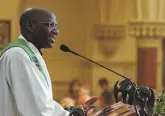Detroit archdiocese’s parish restructuring aims for more than mergers
CNA Staff, Jun 3, 2020 / 04:01 pm MT (CNA).- The Archdiocese of Detroit has announced a major restructuring process that could combine over 200 parishes into “family” groupings that aim to alter and, perhaps, avoid, aspects of the parish merger model.
“Even before the pandemic, we knew God wanted to renew our parishes. The structures we inherited served our mission well in the past, but they need to be renewed and aligned for mission,” Archbishop Allen Vigneron said in a May 31 announcement.
“And so, in prayer and in consultation with others, I’ve discerned that this is the time to respond in faith to our new reality and to better equip our parish communities for mission,” he said.
The changes envision groupings of three to six parishes, in what the archdiocese is presenting as a “family of parishes” model. The archdiocese expects about 60 to 80 “family” groupings to be formed from its 218 parishes. These parishes serve about 1.4 million Catholics.
Among the difficulties for the archdiocese is the aging of its clergy.
Almost two-thirds of the 382 priests in the archdiocese are older than 60. With an average age of 64 in 2018, many of the priests are near retirement. The coronavirus epidemic could worsen the problem, if older priests become ill from the disease or retire early due to health concerns, the archdiocesan news site Detroit Catholic reported.
The “parish family” model differs from a parish-merger model because each parish in a “family” group would retain its identity under canon law, the Detroit Catholic reports. However, it would share a leadership team that could include priests, deacons, pastoral ministers, and other parish staff.
This model would not make one priest responsible for multiple communities, which can cause burnout and isolation. Rather, several priests and deacons would work together to administer the parishes and serve parishioners’ sacramental needs, providing better bonds among clergy.
The changes are presented at the Families of Parishes website.
According to its frequently asked questions section, the merged parish model “leaves the parishioners feeling as if they do not have the support that they want and need from clergy.”
In the planning process, teams of clergy and lay leaders will discuss various options for how to lead and govern parish families. This discussion will follow models like that of the neighboring Diocese of London.
The new model could still mean parish closures.
“As each ‘family’ discerns how to best align resources, they may decide to retain their separate identities and worship spaces,” the Families of Parishes’ frequently-asked questions said. “Others, after a careful and honest review of existing resources, may opt to close worship spaces or merge with partnering parishes.”
Some staff could be cut, for instance, if each grouping opts to share a single bookkeeper. The archdiocese said it is possible some groupings could add positions to better serve their mission.
The groupings of parishes will be announced in Advent.
The archdiocese plans for half of the parishes to begin to operate in the new model by July 2021, with the other half intended to shift to the model by July 2022. Six months of preparation are planned for the parish change.
In this time, each group of parishes will discuss practical problems about clergy, staff, and parish interaction. They will finalize leadership structure and staff positions, and consider changes to Mass and confession schedules to help accommodate parishioners.
Archbishop Vigneron asked for prayers for this “very important step in the life and mission of our local Church.”













